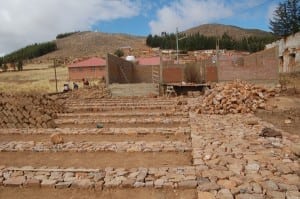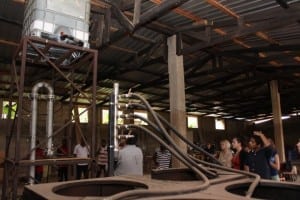
The partially constructed pine nursery in the rural Bolivian municipality Cuchumuela will be fertilized from toilets and host to mushroom crops. Photo credit: Water for People
This is a story of how mushroom sales are solving a sanitation problem in rural Bolivia. Or if you’re a rural Bolivian, it’s a story of how building toilets can improve the mushroom harvest. It’s a question of perspective. Let’s start with toilets.
There are not enough toilets in rural Bolivia. Fewer than half of the people have regular access to sanitations systems, and fewer than one out of 10 rural Bolivians have private toilets, the World Health Organization reports.
No luck with free toilets
Giving away free toilets, however, has not solved the problem. Or, rather, it has only solved part of the problem. Development organizations have had the good idea to equip rural Bolivian communities with urine-diverting dry toilets, which compost the solid waste and divert the urine from a cup in the front of the bowl to a separate tank where it is fermented to become fertilizer. (For other ecological toilet designs, see our Solutions Library.)
Most people, however, don’t use them. Depending on the study, only one fifth to one half are used often and correctly. Further, a telling ethnographic study by the Netherlands Development Organisation (SNV) reports that when asked the benefits of such toilets, most people who use them do not mention that they improve community health, produce free fertilizer, or operate without water or plumbing. Instead, the top benefit is that they are provided for free. When the survey-makers came by, however, the Bolivians hadn’t known about the mushrooms, yet.

This is what all the fuss is about: a bolete mushroom. Photo credit: Water for People
Oops, mushrooms
Fifteen years ago, the Bolivian state of Cochabamba reforested part of the municipality of Cochumuela, located about one and half hours from the state capital, right in the middle of the country. The Monterrey pines (Pinus radiata) they planted happened to be hospitable to a kind of mushroom called a bolete.
Boletes, it turns out, are delicious, and expensive in Bolivia. A family in Cochumuela can earn about $800 (US) per year from mushroom sales, the SNV found. Reforestation in Cochumuela served not only to balance water tables and conserve top soil, but produced an unintentional cash crop as well. The harvest, however, isn’t big enough for everyone to take part.
Water for People
To grow more mushrooms, people in Cochumuela need more pines. The new pines need fertilizer. That happens to be one of the several specialties of urine-diverting dry toilets. Local business groups hit on that connection, and Water for People-Bolivia, a branch of the international water and sanitation aid organization, listened.

Latrines are built with dirt-filled plastic bottles to recycle waste and reduce construction costs. Photo credit: Water for People
“The beauty of this is that it is a local, homegrown idea that just needed a little support to get going, Kate Fogelberg, a regional manager for Water for People, told E4C in an email. “WFP played the role of a facilitator, bringing together business experts, agricultural investigators, the local government and the communities to explore the business opportunity.”
Plastic bottles and fermented urine
Now, Water for People is part of a profit-driven pilot program. The communities have built 100 toilets walled with dirt-filled plastic bottles. (The recycled construction materials cost 20% less than a comparable brick building). They collect urine for transport to a fermentation center and compost the solid waste on site. They plan to plant and fertilize pine trees, then build more toilets and plant more trees using money from mushroom sales.
The nursery should be finished by year’s end and the first pines should be planted next year. Trials with the fertilizer are underway now.
How to help
You can visit Water for People’s site to donate online. The organization also needs skilled volunteers to overseer projects. For information on their diverse volunteer programs, visit their World Water Corps site.
Resources
Water for People’s report (pdf)
Ecological toilet design
Composting toilet in waterlogged areas
Ventilated improved pit latrine

